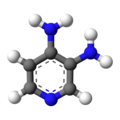3,4-Diaminopyridine
 |
|
 |
|
| Clinical data | |
|---|---|
| Trade names | Firdapse |
| AHFS/Drugs.com | UK Drug Information |
| Pregnancy category |
|
| Routes of administration |
Oral |
| ATC code | |
| Legal status | |
| Legal status |
|
| Pharmacokinetic data | |
| Bioavailability | 93–100% |
| Metabolism | Acetylation to 3-N-acetylamifampridine |
| Biological half-life | 2.5 hrs (amifampridine) 4 hrs (3-N-acetylamifampridine) |
| Excretion | Renal (19% unmetabolized, 74–81% 3-N-acetylamifampridine |
| Identifiers | |
|
|
| CAS Number | |
| PubChem CID | |
| IUPHAR/BPS | |
| ChemSpider | |
| UNII | |
| KEGG | |
| ChEMBL | |
| ECHA InfoCard | 100.000.201 |
| Chemical and physical data | |
| Formula | C5H7N3 |
| Molar mass | 109.13 g·mol−1 |
| 3D model (Jmol) | |
| Melting point | 218 to 220 °C (424 to 428 °F) decomposes |
| Solubility in water | 24 mg/mL (20 °C) |
|
|
|
|
|
|
|
Amifampridine (pyridine-3,4-diamine, 3,4-diaminopyridine, 3,4-DAP) is used as a drug, predominantly in the treatment of a number of rare muscle diseases. The free base form of the drug has been used to treat congenital myasthenic syndromes like Lambert–Eaton myasthenic syndrome (LEMS) through compassionate use programs since the 1990s and was recommended as a first line treatment for LEMS in 2006, using ad hoc forms of the drug, since there was no marketed form.
Around 2000 doctors at Assistance Publique – Hôpitaux de Paris created a phosphate salt form, which was developed through a series of companies ending with BioMarin Pharmaceutical which obtained European approval in 2009 under the trade name Firdapse, and which licensed the US rights to Catalyst Pharmaceuticals in 2012. As of January 2017, Catalyst and another US company, Jacobus Pharmaceuticals, which had been manufacturing the free base form and giving it away for free since the 1990s, were racing to obtain FDA approval for their versions first; the company that obtained the approval would have seven years of marketing exclusivity.
Amifampridine phosphate has orphan drug staus in the EU for Lambert–Eaton myasthenic syndrome and Catalyst holds both an orphan designation and a breakthrough therapy designation in the US.
Amifampridine is used to treat many of the congenital myasthenic syndromes, particularly those with defects in choline acetyltransferase, downstream kinase 7, and those where any kind of defect causes "fast channel" behaviour of the acetylcholine receptor.
It is also used to treat symptoms of Lambert–Eaton myasthenic syndrome.
...
Wikipedia
